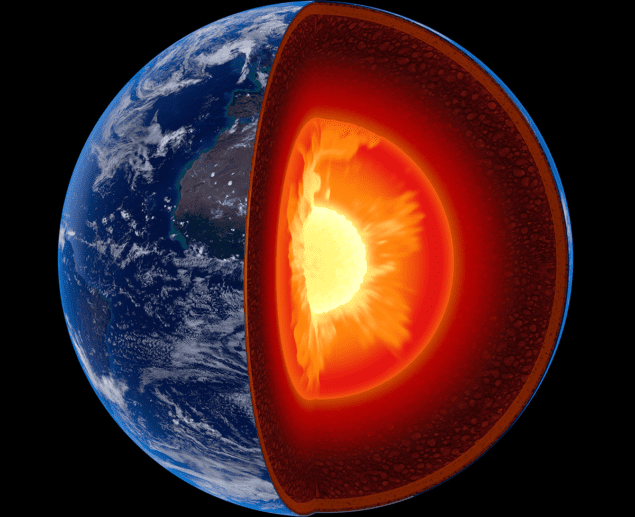
A new method for studying high-pressure samples has been developed by researchers in Germany. Their approach involves doing X-ray emission spectrography at a synchrotron facility and supports the idea that magma in the Earth’s lower mantle is stabilized by the accumulation of heavy elements.
Magma rises in Earth’s crust because it is less dense than surrounding material of the same composition. However, magma in the Earth’s lower mantle appears more stable, suggesting there it has a similar density to its surroundings. It has been proposed, therefore, that either magma in the mantle is enriched by heavy elements such as iron, or that at extreme pressures a special compaction mechanism increases magma density.
To investigate how materials behave at mantle depths, researchers create extreme pressures by compressing samples in a diamond anvil. X-rays – energetic enough to pass through the sample and short enough in wavelength to resolve atomic-scale details – are then used to determine the sample’s structure. Two such methods are traditionally used in high-pressure research, with one based on the absorption of X-rays and the other on their diffraction as they pass through the sample.
Energy and intensity
Now, Georg Spiekermann of the University of Potsdam and colleagues have developed a third X-ray method that can determine both the atomic bond lengths in disordered matter and the number of direct neighbours an atom has – the so-called “coordination number”. An increase in coordination number under high pressure would be one sign of a heightened compaction mechanism. The new approach works by exciting a sample with X-rays, and then analysing the radiation emitted. The energy and intensity of a particular emission line – dubbed Kβ” – can be used to determine the co-ordination number and bonding distance, respectively.
Using the PETRA III X-ray source at DESY in Germany, the researchers applied the technique to compressed amorphous germanium dioxide – whose structure is analogous to that of the main content of magma, silicon dioxide. They found that even at pressures of 100 GPa (found in the mantle at a depth of 2200 km), the germanium atoms never have more than six neighbours. This is similar to that measured at 15 GPa, suggesting no special compaction mechanism.
Far reaching consequences
“Transferring this to silicate magmas in Earth’s lower mantle, this means that magmas with a density equal or higher than that of surrounding crystals can only be reached by enrichment of heavy elements like iron, ” Spiekermann explains. “The composition and structure of the lower mantle has far reaching consequences for the global transport of heat and for Earth’s magnetic field.”
James Drewitt, a geophysicist from the University of Bristol, comments, “This is an interesting result because it reduces the likelihood of a density cross-over between oxide magmas and the surrounding solid deep lower mantle”.
Drewitt, who was not involved in the study, also points out that “this result is in direct conflict with recent synchrotron X-ray diffraction measurements of both germanium dioxide and silicon dioxide glass at high pressure”. These studies indicate that local structural units with more than six oxygen atoms occur at ultra-high pressures. While more investigations are needed to resolve this controversy, he concludes, the new approach represents an important tool to study deep planetary interiors.

X-rays probe the origins of hotspot volcanoes
With their initial study complete, Spiekermann and colleagues are considering more complex materials, such as those that – like natural silicate melts – contain modifying oxide compounds. Studying these requires consideration not only of an atom’s nearest neighbours, but also atoms a bit further away in the “second coordination shell”.
“For example, the degree of polymerization of a network is a second coordination shell effect,” Spiekermann notes, adding: “We will show in the future that Kβ” is sensitive to the degree of polymerization of a glass, which is beyond the capabilities of other X-ray techniques.”
The research is described in the journal Physical Review X.



